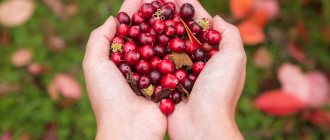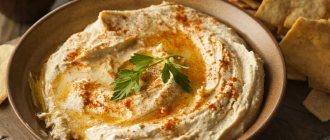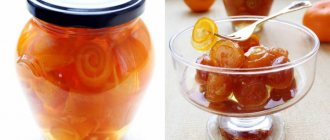Properties of dried figs
Nutritional value and composition | Vitamins | Minerals
How much does dried fig cost (average price per 1 kg)?
Moscow and Moscow region.
220 rub.
Figs are the fruit of a fairly tall large-leaved tree that can be found in the southern latitudes of our big planet. The color of these fragrant fruits is most often purple, but you can also find light yellow figs; they taste sweetish, but with a slight hint of sourness. Dried figs are known all over the world for their beneficial properties, however, experts are of the opinion that before you start using this product on a regular basis, you need to carefully study its positive and negative effects on the human body.
Since figs are a highly perishable product, they must be eaten fresh within 6 hours after they were picked from the tree, which is probably why they are found mainly in dried form on our shelves. There is an opinion that high-quality dried figs taste much more pleasant in many ways than fresh ones. Also, the advantages of dried figs include the fact that you can easily get them in any city and in any country, unlike fresh ones, which do not grow everywhere. For vegetarians and vegans, dried figs are one of the favorite foods as they are truly sweet and have a unique taste.
What are the benefits of figs?
Fresh figs contain quite a lot of different sugars, but this will not cause you to gain extra pounds, because... These sugars quickly satiate and suppress hunger. Figs also contain a lot of fiber, which is formed by the seeds, which also help improve digestion.
Organic acids, vitamins, minerals, micro- and macroelements contained in figs improve the body's metabolic processes. Figs have a diuretic effect, which has a positive effect on kidney function. Due to its high potassium content, it has a beneficial effect on the cardiovascular system. By thinning the blood, it dissolves blood clots in blood vessels and helps reduce blood clotting. It is an excellent preventative for hypertension.
Benefits of dried figs
The benefit of dried figs lies in the large number of trace elements, minerals and vitamins contained in the product. The amount of protein during the drying process increases to 5 percent, while fresh figs contain only 1 percent protein. The beneficial properties of dried figs are largely due to the fact that they store the largest supply of fiber among all dried fruits, so the feeling of fullness when consuming this product comes quite quickly, and the functioning of the gastrointestinal tract becomes more stable. The calorie content of dried figs is quite high, so by eating 2-3 fruits you will provide yourself with a sufficient supply of energy.
It is also necessary to mention that the beneficial properties of dried figs are also known throughout the world because they contain a large amount of pectin, which turns dried figs into a valuable food product. Thanks to pectin, the healing of connective tissues is accelerated, which is a very important factor for injuries to various joints, as well as bones. The benefits of dried figs are also manifested in their ability to increase the antioxidant activity of blood plasma. In addition, dried figs contain a substance such as rutin, due to which the walls of capillaries are strengthened and vitamin C is better absorbed.
Chemical composition of figs
Dried figs are considered a real champion in terms of mineral content. It is especially rich in iron and potassium, calcium and phosphorus, and magnesium. It also contains vitamins necessary for the body. Quite a lot of vitamins such as: PP and C, B1 and B6, as well as B2. The dried fruit also contains unsaturated fatty acids Omega-3 and Omega-6, and not many fruits can boast of such a composition.
No less important components in figs are syringic and gallic acids, which have bactericidal properties and help maintain a balanced intestinal microflora. For the same purpose, the body also uses fiber, of which there is quite a lot in the product.
Dried figs: benefits and harms, calorie content
Adults and children love to treat themselves to sweet treats. But in the wake of the popularity of proper nutrition and a healthy lifestyle, most of them are increasingly abandoning the usual sweets and chocolates in favor of less harmful analogues. An excellent alternative to sweets would be dried figs, the benefits and harms of which we will consider in more detail.
What do we know about figs?
In order for figs to grow juicy and sweet, they need a hot, humid climate. That is why the Black Sea coast is famous for such fruits: Türkiye and Crimea, as well as Greece.
Figs are also called fig trees or fig trees. Its fruits are extremely tender and soft. They are very sensitive to any damage.
The most delicious figs are the ones picked from the tree, because they can be stored for only a short time. A slight damage to the delicate skin of the fruit reduces its shelf life to several hours.
This is why dried figs have become very popular. The benefits and harms of fruits will be discussed in detail below. In this form, the dried product is absolutely not inferior to fresh fruit, but can be stored much longer. Therefore, if you didn’t manage to enjoy figs to your heart’s content while relaxing on the Black Sea coast, stock up on dried figs and enjoy their taste all winter long!
Fresh or dried?
Those who are intimately familiar with fig tree fruits often doubt whether dried figs should be included in their diet. The benefits and harms of such fruits may be controversial, but they are completely unfounded.
Dried figs retain their entire vitamin and microelement composition. Moreover, absolutely no preservatives are used to obtain such dried fruits. This means that dried figs are definitely beneficial for the body.
It is only worth considering that when dried, the concentration of constituent substances in the fruits noticeably increases, as well as the energy value.
So, if 100 grams of fresh figs contain up to 50 kcal, then the same weight of dried fruit will “bring” up to 300 kcal! This factor should definitely be taken into account when considering the benefits and harms of dried figs: calorie content is an important aspect, especially for women.
A storehouse of vitamins and microelements
Many people do not even suspect how rich the composition of the fig tree fruit is. In terms of iron content, figs surpass even the apple, which is known to everyone as a storehouse of this element.
Try replacing your usual pharmacy vitamins with dried figs: the benefits and harm to the body will not be comparable.
By including this product in your diet, you will daily replenish your body with natural vitamins and other beneficial substances that are free of any chemical additives.
You can compare the composition of pharmacy vitamins indicated on the packaging with the microelements that are included in figs. You will be pleasantly surprised. The fruits of the fig tree contain:
- minerals: iron, sodium, calcium, potassium, zinc, manganese and magnesium;
- vitamins: ascorbic acid, vitamin A, B vitamins;
- organic acids: malic, aspartic, glyceric;
- pectin;
- lysine;
- cellulose;
- sugars: glucose, fructose and sucrose.
Thanks to its natural composition, all beneficial substances are perfectly absorbed and do not cause allergic reactions or side effects. There is debate about the benefits and harms of dried figs, but what is truly beyond doubt is its rich vitamin composition. This magical fruit simply must be a regular guest in every kitchen.
What about the diet?
Often people who are struggling with excess weight try to give up eating sweets, but cannot do it radically. Then they resort to tricks: replacing chocolates and cakes with dried fruits and candied fruits. In this article we will study in detail the photos, benefits and harms of dried figs, and find out whether you can eat them while on a diet.
The answer is quite simple: such fruits are definitely better than any store-bought sweets. Despite the rather high calorie content, this product does not contain a large amount of fat, unlike any cakes and cookies.
Yes, dried figs are rich in sugars, but this only means that you should not abuse them. You can safely eat 3-4 fruits a day without damaging your figure.
Therefore, do not be afraid to pamper yourself with dried figs during your diet. The benefits and harms of this product cannot be compared. The fruit contains many more beneficial qualities than harmful ones.
If consumed in moderation, it will fit perfectly into the diet menu for weight loss.
Figs as medicine
The rich composition of figs has been widely used in folk medicine for many years to treat a wide variety of diseases.
Fig tree fruits have a pronounced laxative effect, so they will become an effective and tasty helper for people suffering from constipation.
This product will relieve pain and severity of symptoms in the following diseases:
- inflammatory processes in the gastrointestinal tract;
- digestive disorders of various origins;
- urolithiasis and cystitis;
- liver damage, intoxication;
- vascular and heart diseases;
- bronchitis, persistent cough, sore throat;
- soft tissue injuries, poorly healing wounds.
The properties of dried figs make it possible to forget about many health problems without resorting to complex drug therapy or combining it with a sweet treat. For treatment, it is necessary to use tinctures and decoctions of fig tree fruits, the recipes for which we will consider below. But for prevention, you just need to include figs in your daily diet.
Delicious prevention
Regular consumption of fig fruits, fresh or dried, saturates the body with beneficial elements in such quantities that this becomes sufficient for the prevention of various diseases.
A large amount of vitamin C makes figs an indispensable product during periods of viral and colds.
Its excellent effect on vascular and cardiac muscle tone helps prevent the development of varicose veins, thrombophlebitis, and coronary heart disease.
Figs serve as an excellent means of maintaining hemoglobin at a high level, and therefore preventing anemia. Its effect on blood properties reduces the risk of blood clots and cholesterol plaques on blood vessels.
There is no need to buy large quantities of vitamin and immunomodulatory drugs: it is enough to eat dried figs every day, because they are tasty and effective in preventing many diseases.
Making a medicinal infusion or decoction yourself is not at all difficult. It is enough to put 40–50 grams of dried figs in a clean glass container.
Top the dried fruits with 200 ml of boiled water or milk, the temperature of which should be about 60–80 degrees. The decoction should steep for at least 6 hours and be stored for no longer than a day.
Therefore, it is most convenient to pour the figs at night, and in the morning drink the resulting infusion in small sips throughout the day.
You can make compote from dried figs. Whether this drink will be beneficial or harmful depends on the presence of contraindications. If none of your loved ones have had negative reactions to the product, you can safely include it in your diet. This compote will be not only tasty, but also a healthy addition to family meals.
Be careful!
Like any product with a rich composition, fig fruits in rare cases can have a negative effect. The harm of dried figs is purely individual and can only occur in specific cases.
Due to the oxalic acid it contains, the fruits are contraindicated for people suffering from gout. Figs can provoke an exacerbation of the disease.
Dried figs contain a large amount of sugar, and therefore should not be consumed by people with diabetes.
Dried figs are also excluded from the diet of pregnant women who are prone to excessive weight gain. Despite the vitamin-rich composition, it is better to avoid eating fruits in case of late toxicosis and breastfeeding.
Otherwise, there were no negative consequences from eating figs. Therefore, if you do not suffer from the ailments listed above, eat it boldly, but in moderation!
Benefits with taste!
Now you know about the wonderful properties of heat-loving figs and, undoubtedly, you will want to include them in your family’s diet. This is a great alternative to candy. Slowly replace all the sweets in the house with dried fruits, and you will be pleasantly surprised by the changes in the health of your loved ones.
Make compotes, jam from figs, and add to baked goods. The taste of this fruit is completely unique, and the health benefits are invaluable.
But always remember about moderation: in reasonable quantities, figs will be an indispensable helper and a storehouse of vitamins, but if overused, they can become a source of extra pounds! Eat right and be healthy!
Application
Figs are eaten both fresh and dried. Dried figs have wonderful taste. It is used to prepare compotes and pie fillings. Dried figs go well with red wine, nuts and cheese. In addition, medicinal decoctions are prepared from dried figs to treat coughs, sore throats, remove kidney stones and many other diseases.
Market Analytics
- COVID-19 is changing the rules of the game in the cosmetics market
- Beauty of the future: cosmetic innovations 2020
- New ingredients are the driving force of the cosmetics industry
Convenient search for beauty salons on our website
Beauty salons in Moscow Beauty salons in St. Petersburg Beauty salons in Ekaterinburg Beauty salons in Novosibirsk
Latest blog posts on our website
- Naturecream / Geranium (Pelargonium) oil for skin health and beauty
- Prostye-sovety / Save on a beauty salon: procedures that can be done at home
- Naturecream / Growth Factor - brings back youth?
- Oksana-Lezina / 3 effective abdominal exercises from a fitness instructor for beginners
- Prostye-sovety / Making perfect curls at home
- Prostye-sovety / Which hair removal method to choose
- Naturecream / Wrinkles Puppets
- Naturecream / PEPHA-TIGHT - instant skin lifting
- Naturecream / Blue light - a danger to the skin
- Naturecream / Cocoa Butter – A treat for the skin
Latest forum topics on our website
- Mrs._Smith / Badly sunburned! What to do?((
- Ice / Is it necessary to combine fitness classes with a diet?
- Antonova / What can be used for hair loss?
- Radio operatorKat / Who was on a protein diet?
- Suzanna / Mesotherapy on the face
Other articles in this section
| Kola nut The very name of this product speaks of how popular and in demand it is. Famous drinks whose names end with “cola” have won the hearts and stomachs of millions of people on the planet. However, many still do not know the nature of this wonderful drink. It should be noted that the management of the company that produced the drink kept the production technology secret for more than a hundred years. And the drink is made precisely from the plant of the same name, the fruit of which is a nut. |
| Dried peach Peach is a southern fruit tree belonging to the Rosaceae family. China is considered the birthplace of the peach. Valued for its tasty, juicy and aromatic fruits. Peach is used to make jam, compotes, jams, and is also used in dried form. |
| Candied melon Melon has been known to people for about four thousand years, and candied fruits from it have existed for the same, or almost as long, time. Melon was a sacred fruit in ancient Egypt and was offered as a sacrifice to the gods. At the same time, melon was grown in Asia. It spread widely in the countries of the East, where it was highly valued for its refreshing taste and ability to quench thirst. In European countries, this berry was also very popular, and it began to be grown in almost all countries. |
| Candied carrots It is generally accepted that candied fruits are traditionally made only from fruits and berries, but this is not entirely true. Along with candied fruits and berries, candied vegetables have also been prepared for a long time: carrots, pumpkins, turnips, beets. It turned out that when candied, these vegetables are very tasty and, like fruits or berries, retain all their beneficial properties. |
| Brazil nut Brazil nut is one of the tallest trees in the Amazon rainforest. Its fruits are contained in oval boxes, which are quite impressive in weight - the weight can reach 2 kilograms, and the diameter is -15 centimeters. The homeland of Brazil nuts is South America. The fruits of the tree are collected only in wild forests. The main consumers of nuts are animals, birds and insects. |
| Candied pears Candied pears are fruits boiled in sugar syrup and then candied during the drying process. |
| Dried apples Dried apple is one of the most famous and consumed fruits in the world. The well-known Phoenicians grew this fruit and revered it with special passion. Dried apple ranks first among fruits in terms of the amount of vitamins it contains. For proper drying, it is recommended, first of all, to use a ripe apple with sufficiently dense pulp. |
| Dried cranberries Scarlet islands of ripe cranberries are spread out in intricate archipelagos across the lowlands of swampy forests. Who is not familiar with this enchanting picture of Russian nature?! Cranberries have been collected in Rus' since time immemorial. It is an inexhaustible source of vitamins, combining anti-inflammatory, bactericidal, and antimicrobial properties. |
| Candied papaya Papaya first came to the European continent in candied form (in the form of candied fruit) in the 16th century. This exotic fruit has been cultivated by the Indians of Central America and Mexico since ancient times. They valued papaya very much for its medicinal properties and rapid growth. After the discovery of America, Europeans also learned about papaya. Due to the resemblance of papaya fruits to melon, they dubbed it the “melon tree.” Another name for papaya is “breadfruit”, as the fruit smells like fresh bread when baked. Appreciating the beneficial properties of this exotic plant, Europeans began attempts to cultivate it in southern Europe and Africa. Thanks to her unpretentiousness, she took root there perfectly. In Russia, attempts have recently begun to grow papaya in the south of the country; now there are trial plantings there. |
| Poppy Poppy is a genus of annual or perennial herbaceous plants of the Poppy family. The poppy fruit is a cylindrical or spherical capsule, covered with a ribbed disk on top. In the middle of the fruit capsule there are many small seeds of black, gray or gray-white color. |








